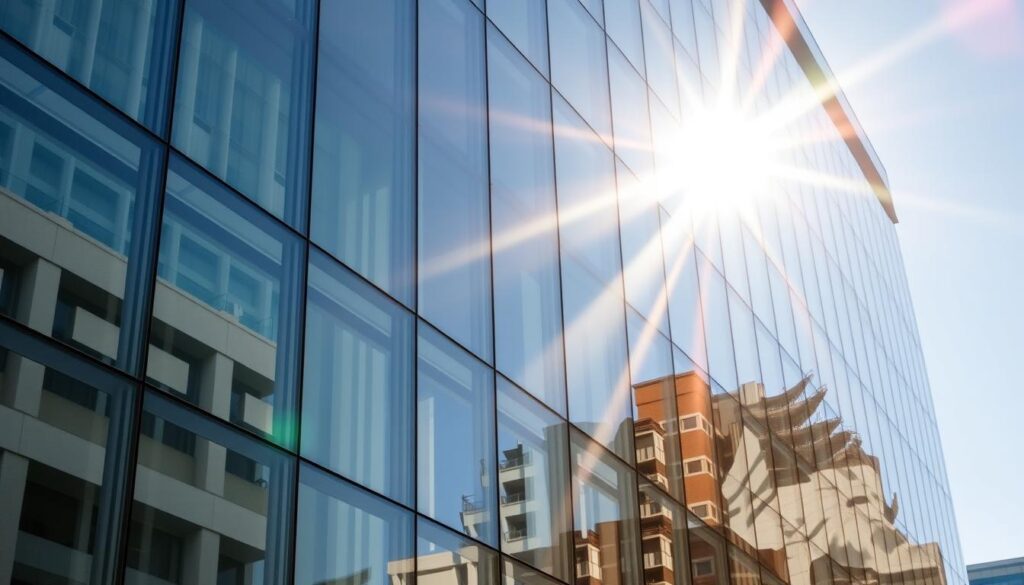When designing a building, one of the most critical decisions is selecting the appropriate façade glazing. The choice of glazing can significantly impact the building’s aesthetics, energy efficiency, and safety. But what makes a glass facade truly exceptional?
Building codes regulate the performance of glass, with different requirements based on the type of fenestration, whether it’s vertical or skylight. With various options available, including different types of structural glazing, choosing the right one can be daunting. The right glazing can enhance the building’s appearance while improving its overall performance.
Key Takeaways
- Understanding the impact of façade glazing on building aesthetics and energy efficiency.
- Recognizing the importance of building codes and regulations.
- Exploring different types of glazing options for your building.
- Considering factors that influence the choice of glazing.
- Learning how to balance design preferences with functional requirements.
Understanding Façade Glazing
Façade glazing, comprising the glass or glazing elements on a building’s exterior, is fundamental to its architectural appeal and performance. It is an integral part of the curtain wall system, which is a non-structural exterior covering that provides weather protection and aesthetic appeal.
For a deeper understanding of façade glazing, it’s essential to explore its definition and significance in building design.
Definition of Façade Glazing
Façade glazing refers to the glass or other glazing materials used in the exterior of a building. It is a critical component of architectural glazing, contributing to the building’s overall aesthetic and functional performance. The choice of glazing material can significantly impact the building’s energy efficiency, daylighting, and occupant comfort.
“The right glazing solution can transform a building’s façade, enhancing its visual appeal while improving its energy performance.”
Importance in Building Design
Façade glazing plays a vital role in building design, affecting both the building’s appearance and its functional benefits. It is not just about aesthetics; façade glazing is also crucial for energy efficiency, natural lighting, and the overall occupant experience. As noted in a discussion on architectural vision with structural glass, the selection of appropriate glazing can significantly enhance a building’s sustainability and livability.
By understanding the principles of façade glazing, architects and builders can make informed decisions that balance aesthetic goals with functional requirements, ultimately contributing to more sustainable and appealing buildings.
Types of Façade Glazing Materials
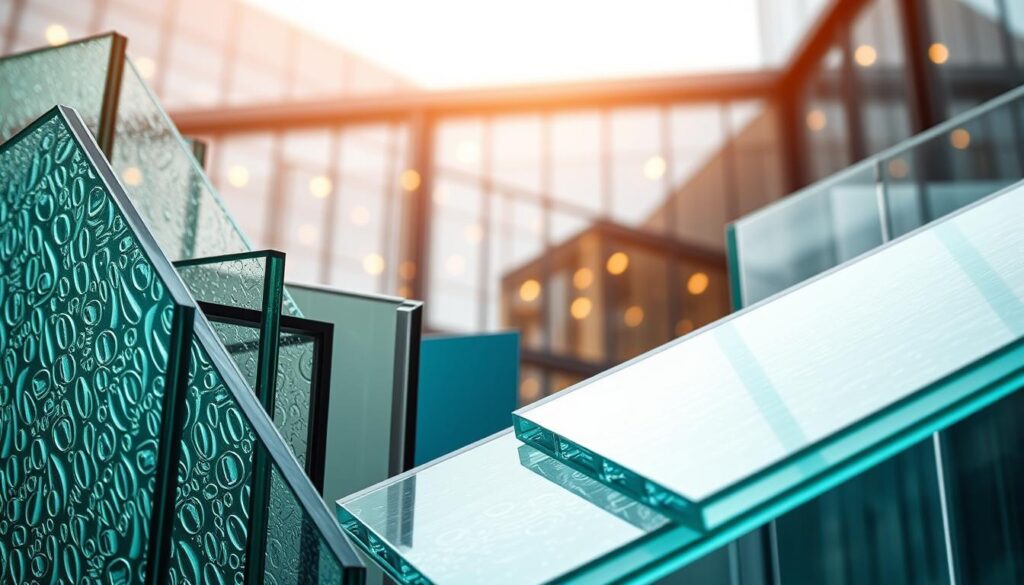
When it comes to choosing the right façade glazing, understanding the different materials available is essential. The type of glazing material used can significantly impact a building’s energy efficiency, aesthetics, and overall performance.
Glass Options: Tempered vs. Laminated
Two popular types of glass used in façade glazing are tempered glass and laminated glass. Tempered glass is known for its strength and durability, making it a popular choice for building façades. It is processed by heat treatment to increase its resistance to thermal stress and mechanical impact.
Laminated glass, on the other hand, consists of multiple layers of glass bonded together with an interlayer, typically made of polyvinyl butyral (PVB). This construction provides excellent soundproofing and security benefits, as laminated glass holds together even when broken.
Performance Characteristics of Glazing Materials
The performance characteristics of glazing materials vary widely, depending on their composition and construction. For instance, insulated glass units (IGUs) are designed to minimize heat transfer between the interior and exterior of a building, enhancing energy efficiency.
Glazing materials can also be evaluated based on their solar control properties, impact resistance, and acoustic performance. For example, some glazing materials are designed to reduce solar heat gain, while others prioritize daylighting and visibility.
| Glazing Material | Energy Efficiency | Impact Resistance | Acoustic Performance |
|---|---|---|---|
| Tempered Glass | Moderate | High | Low |
| Laminated Glass | Moderate | High | High |
| Insulated Glass Units (IGUs) | High | Moderate | Moderate |
Eco-Friendly Glazing Solutions
In recent years, there has been a growing emphasis on eco-friendly glazing solutions. These include materials and technologies designed to reduce environmental impact, such as structural glazing systems that maximize natural light and minimize the need for artificial lighting.
Eco-friendly glazing options also encompass materials with low embodied energy, recyclable materials, and those that contribute to improved building energy efficiency. By choosing the right glazing materials, architects and builders can significantly reduce a building’s carbon footprint.
Energy Efficiency Considerations
As the world shifts towards sustainable building practices, the role of energy-efficient façade glazing becomes increasingly critical. Modern buildings require advanced glazing solutions that not only enhance aesthetic appeal but also contribute to reduced energy consumption.
Insulating Glass Units (IGUs)
Insulating Glass Units (IGUs) are a significant advancement in energy-efficient glazing. By sandwiching a layer of gas between two glass panes, IGUs minimize heat transfer, thus reducing the energy required for heating and cooling. This technology is particularly beneficial in extreme climates where buildings are subjected to harsh temperatures.
Key benefits of IGUs include:
- Improved thermal insulation
- Reduced condensation
- Enhanced energy efficiency
Low-Emissivity (Low-E) Coatings
Low-Emissivity (Low-E) coatings are another crucial technology in the quest for energy efficiency. These coatings are designed to reflect infrared radiation, allowing visible light to pass through while minimizing heat transfer. This results in buildings that remain cooler in the summer and warmer in the winter, reducing the reliance on mechanical heating and cooling systems.
“Low-E coatings can significantly reduce the energy consumption of buildings by minimizing heat loss and gain.” –
Solar Control Glazing
Solar control glazing is designed to manage the amount of solar radiation that enters a building. By controlling solar gain, these glazing solutions help maintain a comfortable indoor temperature, reducing the need for artificial lighting and climate control. This not only enhances occupant comfort but also contributes to energy savings.
The integration of these energy-efficient technologies in modern facade design is crucial for achieving sustainable building practices. By incorporating IGUs, Low-E coatings, and solar control glazing, architects and builders can significantly improve the energy performance of building facade systems.
Aesthetics and Design Flexibility
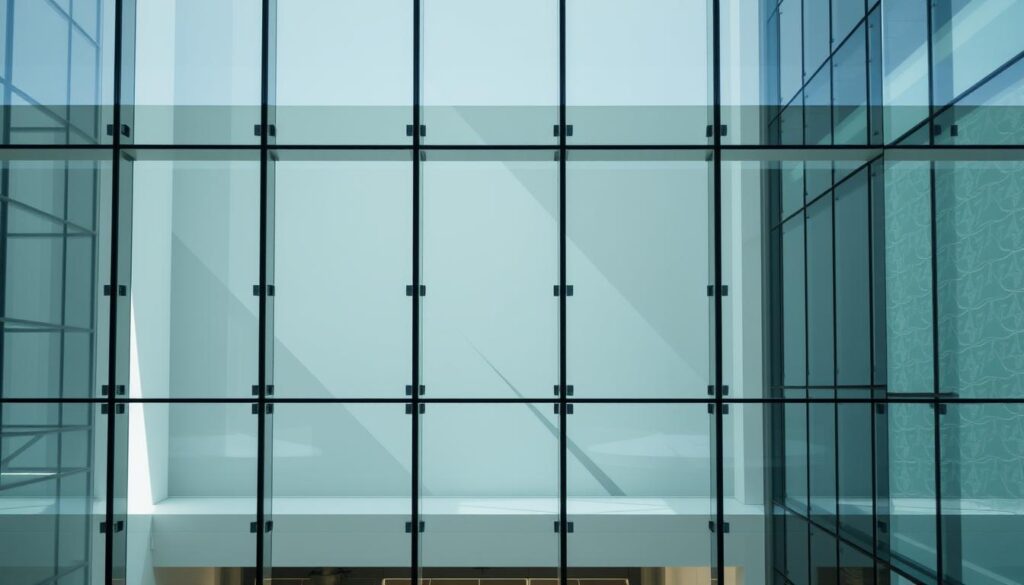
The versatility of façade glazing allows architects to explore various design options, enhancing the visual appeal of buildings. Façade glazing is not just about functionality; it’s also a critical element in the aesthetic design of a building.
Color and Texture Options
Façade glazing offers a wide range of color and texture options, allowing architects to customize the exterior glass design to suit their vision. From transparent to opaque, and from smooth to textured surfaces, the choices are vast.
- Color Variations: Different colors can be achieved through various glazing techniques, including tinting and coating.
- Texture Options: Textured glass can add an extra layer of visual interest and can be used to create unique façade designs.
Customization Capabilities
The customization capabilities of façade glazing are extensive. Architects can work with manufacturers to create bespoke glazing solutions that meet specific design requirements.
Some of the customization options include:
- Custom sizes and shapes to fit unique architectural designs.
- Special coatings for enhanced performance, such as low-E coatings.
- Integrated shading devices for improved solar control.
Relationship with Architectural Styles
Façade glazing can complement a wide range of architectural styles, from modern to traditional. The key is to select glazing options that enhance the building’s design while meeting performance requirements.
For instance, modern buildings often feature large expanses of glass, creating a sleek, contemporary look. In contrast, traditional buildings might incorporate glazing elements that reflect historical design cues.
Structural Integrity and Safety
Ensuring the structural integrity and safety of façade glazing is paramount in modern building design. Façade glazing must comply with rigorous building codes and standards related to structural integrity and safety, including impact resistance and thermal performance.
Code Compliance and Standards
Façade glazing systems, including curtain wall systems, must adhere to local and national building codes. Compliance with these standards is crucial for ensuring the safety and durability of the building envelope. For instance, the International Building Code (IBC) provides guidelines for the design, testing, and installation of façade glazing systems.
“The curtain wall system is a critical component of modern building design, requiring careful consideration of code compliance and safety standards,” notes an industry expert.
Impact Resistance and Building Codes
Impact resistance is a key factor in the safety performance of façade glazing. Building codes often specify requirements for impact resistance, particularly in areas prone to severe weather conditions or high winds. For example, the American Society for Testing and Materials (ASTM) provides standards for testing the impact resistance of glazing materials.
- Façade glazing must meet specific impact resistance standards.
- Compliance with local building codes is mandatory.
- Regular inspections and maintenance are essential for ensuring ongoing safety.
By prioritizing structural integrity and safety, architects and builders can ensure that their façade glazing systems meet the necessary standards for performance and safety. This not only protects occupants but also enhances the overall durability of the building.
Acoustic Performance of Façade Glazing
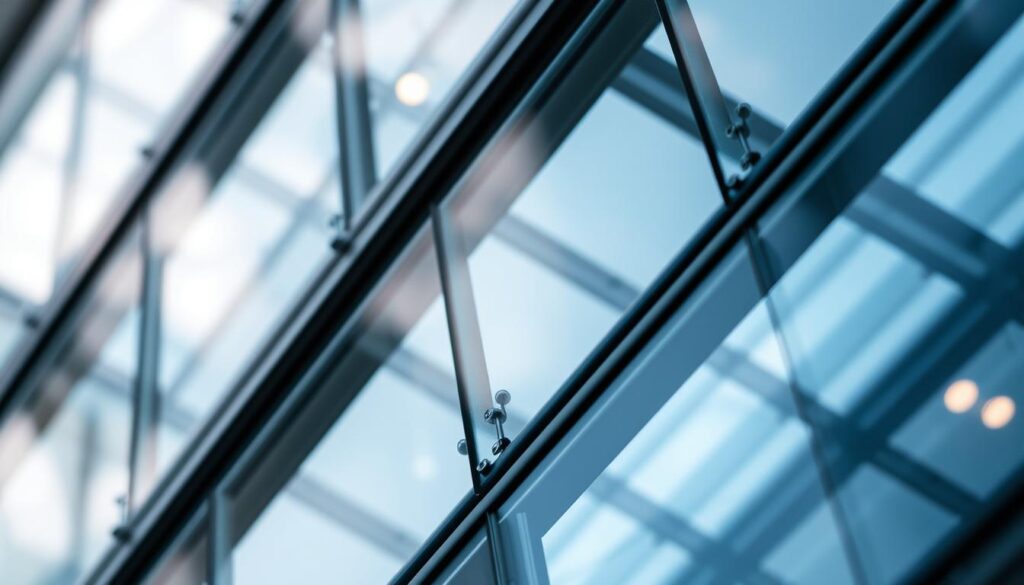
The acoustic performance of façade glazing is a critical consideration in building design, particularly in urban environments where noise pollution is a concern. Effective soundproofing is essential for creating a comfortable indoor environment, and the choice of glazing material plays a significant role in achieving this.
Soundproofing Properties of Different Materials
Different glazing materials offer varying levels of soundproofing. For instance, laminated glass is known for its superior soundproofing capabilities compared to tempered glass. This is because the laminate layer in laminated glass helps to dampen sound waves, reducing the noise that enters the building.
The use of architectural glazing solutions, such as double or triple glazing, can further enhance soundproofing. These systems involve multiple panes of glass separated by gaps, which help to absorb sound energy. As a result, buildings with such glazing systems tend to have lower interior noise levels, contributing to a more comfortable environment for occupants.
Importance in Urban Environments
In urban environments, the importance of effective acoustic performance in façade glazing cannot be overstated. Urban areas are typically characterized by high levels of noise pollution from traffic, construction, and other sources. A well-designed glass curtain wall system can significantly mitigate the impact of this noise, enhancing the overall quality of life for building occupants.
For more information on improving acoustic performance, visit https://wfmmedia.com/improving-acoustic-performance-of-facades/. This resource provides valuable insights into the strategies and technologies available for enhancing the acoustic performance of façades.
By selecting the appropriate glazing materials and designs, architects and builders can create buildings that not only meet but exceed the expectations of occupants in terms of acoustic comfort. This is particularly important in urban settings where the external noise environment can be challenging.
Cost Factors in Façade Glazing
The cost of façade glazing is a multifaceted aspect that includes initial investment, long-term savings, and maintenance costs. Understanding these factors is crucial for building owners and architects to make informed decisions about their building’s envelope.
Initial Investment vs. Long-Term Savings
The initial investment in structural glazing can be substantial, but it’s essential to consider the long-term savings that high-quality glazing can provide. Energy-efficient glazing solutions can significantly reduce heating and cooling costs over the life of the building.
For instance, double-glazed or triple-glazed windows can minimize heat transfer, keeping buildings warmer in winter and cooler in summer. This reduction in energy consumption not only saves money but also contributes to a reduction in the building’s carbon footprint.
Maintenance Costs to Consider
Maintenance is another critical factor in the total cost of façade glazing. Modern facade systems are designed to be durable, but they still require regular cleaning and occasional repairs. The cost of maintenance can vary depending on the complexity of the glazing system and its accessibility.
Using durable materials and designing the façade with maintenance in mind can help reduce these costs over the building’s lifetime. For example, incorporating easy-to-clean glazing or designing the façade with accessible maintenance areas can minimize the need for expensive specialized equipment or scaffolding.
Life Cycle Cost Analysis
A life cycle cost analysis is a valuable tool for evaluating the total cost of façade glazing over its entire lifespan. This analysis considers not only the initial cost but also the costs of operation, maintenance, and eventual replacement.
By conducting a thorough life cycle cost analysis, building owners can make more informed decisions about their façade glazing, balancing initial costs against long-term savings and maintenance needs. This approach ensures that the chosen glazing solution is both cost-effective and meets the building’s performance requirements.
Installation and Technical Considerations
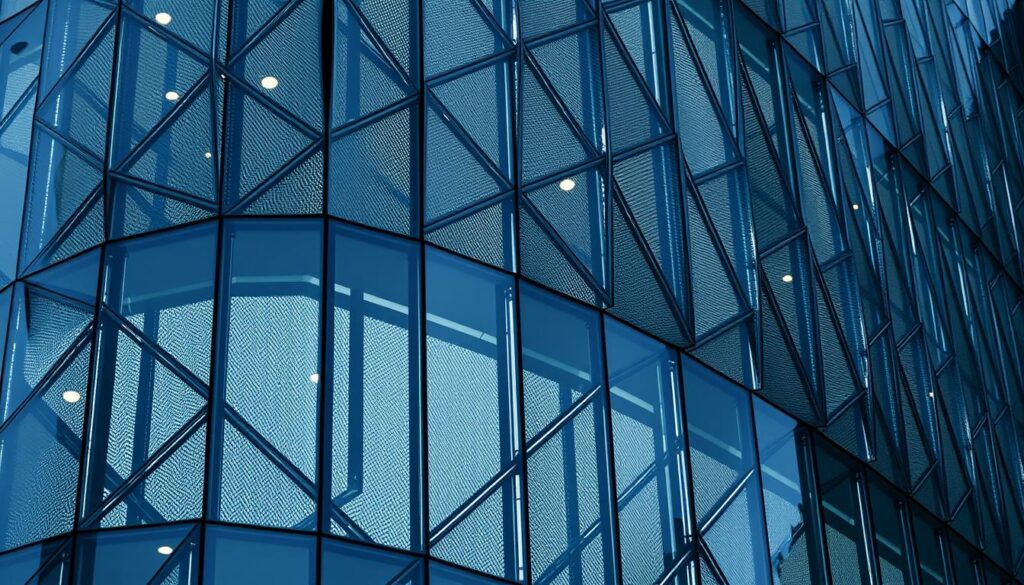
Proper installation and maintenance are essential for maximizing the benefits of façade glazing in modern architecture. The technical aspects of installation play a crucial role in ensuring the performance, safety, and longevity of the glazing system.
Professional Installation Importance
The importance of professional installation cannot be overstated. Experienced installers understand the complexities of façade glazing systems and can ensure that the installation meets all relevant building codes and standards. Professional installation helps prevent issues such as water leakage, air infiltration, and structural problems that can arise from improper installation techniques.
Challenges during Installation
Despite the best planning, challenges can arise during the installation of façade glazing. Common issues include weather conditions, site access limitations, and the complexity of the glazing design. Effective project management and contingency planning are crucial for overcoming these challenges and ensuring a smooth installation process.
| Challenge | Impact | Mitigation Strategy |
|---|---|---|
| Weather Conditions | Delays, safety risks | Flexible scheduling, weather-resistant materials |
| Site Access Limitations | Increased labor costs, logistical issues | Advanced planning, specialized equipment |
| Design Complexity | Installation errors, increased costs | Detailed design specifications, experienced installers |
Maintenance and Accessibility
Regular maintenance is vital for the longevity and performance of façade glazing. Ensuring that the glazing system is accessible for cleaning and repairs is a key consideration during the design and installation phases. Strategies for maintaining accessibility include the use of mechanical equipment and designing the system with maintenance-friendly features.
By focusing on professional installation and planning for maintenance, building owners and architects can ensure that their façade glazing systems perform optimally throughout their lifespan.
Environmentally Sustainable Practices
Environmentally sustainable practices are redefining the façade glazing landscape, offering numerous benefits for buildings and the environment alike. The shift towards greener construction methods has made sustainability a critical factor in modern building design.
The use of recyclable materials in façade glazing is gaining prominence. Many modern glazing materials are designed to be recyclable, reducing waste and the environmental impact of production. For instance, glass is 100% recyclable without any loss of quality, making it an attractive option for eco-friendly buildings.
Recycling and Reusability of Materials
Recycling and reusing materials in façade glazing not only reduces the environmental footprint but also conserves resources. Some of the key practices include:
- Using recycled glass in glazing products
- Designing façades for disassembly and material reuse
- Implementing recycling programs for glazing materials during renovation or demolition
These practices contribute to a more circular economy in the construction industry.
LEED Certification and Green Building Practices
LEED (Leadership in Energy and Environmental Design) certification is a recognized standard for green building practices. Façade glazing plays a significant role in achieving LEED certification through energy efficiency, material selection, and sustainable design practices.
| LEED Criteria | Façade Glazing Contribution | Benefits |
|---|---|---|
| Energy Efficiency | High-performance glazing materials | Reduced energy consumption |
| Material Selection | Recyclable and sustainable materials | Lower environmental impact |
| Indoor Environmental Quality | Natural light optimization through glazing design | Improved occupant health and productivity |
By incorporating sustainable façade glazing practices, buildings can not only reduce their environmental footprint but also enhance their market value and appeal to environmentally conscious occupants.
Fire Safety and Regulations
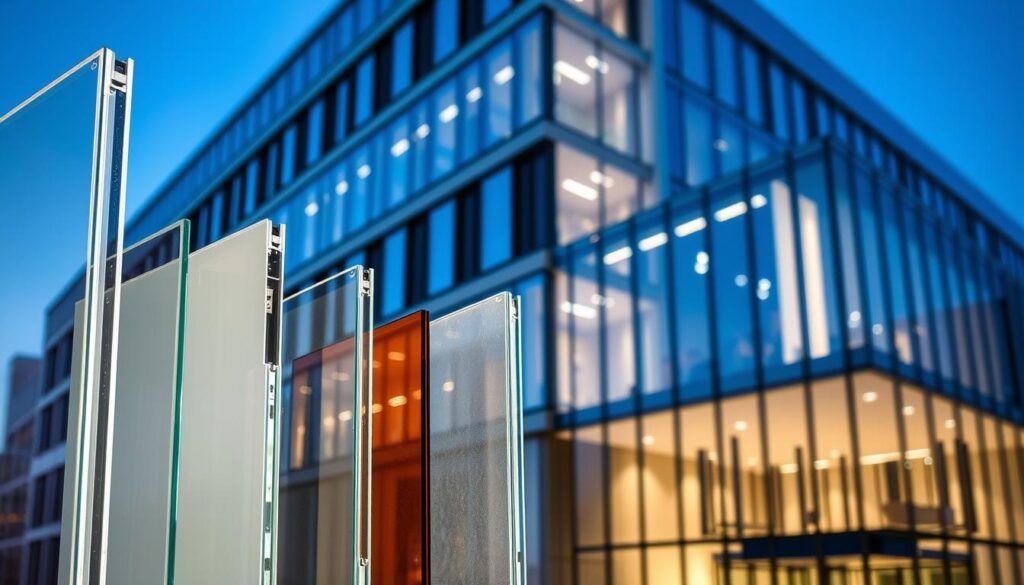
Fire safety regulations play a crucial role in the design and installation of façade glazing systems. Ensuring that façade glazing meets stringent fire safety standards is vital for the safety of building occupants and the structural integrity of the building.
Fire-Rated Glazing Options
Fire-rated glazing is designed to resist the passage of flames and hot gases during a fire, providing critical time for evacuation and firefighting efforts. There are various types of fire-rated glazing materials available, including:
- Tempered glass
- Laminated glass
- Specialized fire-resistant glass
These materials can be used in various curtain wall systems to enhance fire safety.
| Glazing Material | Fire Resistance Rating | Application |
|---|---|---|
| Tempered Glass | Up to 60 minutes | Exterior curtain walls |
| Laminated Glass | Up to 120 minutes | Interior partitions and exterior walls |
Compliance with Local Fire Codes
Compliance with local fire codes is essential for ensuring that façade glazing installations meet the required fire safety standards. Local fire codes often specify the types of glazing materials that can be used, their fire resistance ratings, and installation requirements.
Architectural glazing professionals must be aware of these regulations to ensure that their designs and installations are compliant.
The Role of Technology in Façade Glazing
Technological advancements are transforming the field of façade glazing, offering enhanced performance and efficiency. The integration of technology in façade glazing is not only improving the aesthetic appeal of buildings but also contributing to their sustainability and energy efficiency.
Innovations in Smart Glazing
Smart glazing technologies are revolutionizing the way buildings interact with their environment. These innovations include electrochromic glazing, which can change its tint in response to electrical signals, and thermochromic glazing, which changes color in response to temperature changes. Such technologies enable buildings to adapt to varying environmental conditions, reducing the need for artificial lighting and heating/cooling systems.
For instance, a study on the future of glass façades and glazing in architecture highlights the potential of smart glazing technologies in achieving sustainability and reducing climate control costs. You can read more about this topic on WFM Media.
Integration with Building Management Systems
The integration of façade glazing with building management systems (BMS) is another significant technological advancement. This integration enables the optimization of energy consumption, improves indoor air quality, and enhances the overall comfort of building occupants. By connecting glazing systems with BMS, buildings can dynamically respond to external conditions, such as sunlight and temperature, to minimize energy usage.
For example, electrochromic glazing can be integrated with a BMS to automatically adjust its tint based on the sun’s position, reducing glare and heat gain. This not only improves the energy efficiency of the building but also enhances the comfort of its occupants.
In conclusion, the role of technology in façade glazing is multifaceted, ranging from innovations in smart glazing to integration with building management systems. As the construction industry continues to evolve, the adoption of these technologies is expected to become more widespread, leading to more sustainable, efficient, and comfortable buildings.
Choosing the Right Supplier
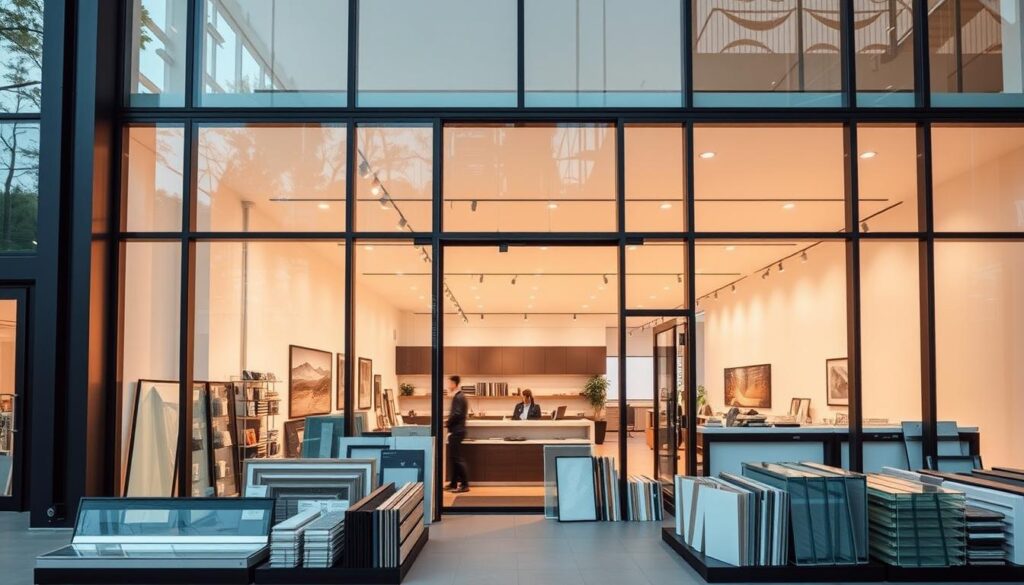
Selecting a trustworthy supplier is vital for acquiring top-notch façade glazing for your modern facade. A reliable supplier ensures that the materials used for your building facade are of the highest quality, meeting both functional and aesthetic requirements.
When evaluating potential suppliers, several factors come into play. It’s essential to assess the manufacturer’s credentials, including their experience, reputation, and certifications. A supplier with a proven track record in delivering high-quality façade glazing solutions is more likely to meet your needs.
Evaluating Manufacturer Credentials
To evaluate a manufacturer’s credentials, consider the following:
- Experience: Look for suppliers with extensive experience in the industry. They are more likely to have encountered and resolved various challenges.
- Certifications: Check for relevant certifications that indicate compliance with industry standards. These certifications can include ISO standards or other local regulatory compliance.
- Reputation: Research the supplier’s reputation through customer reviews, testimonials, and case studies. A good reputation often correlates with high-quality products and reliable service.
Importance of Warranty and Support
A comprehensive warranty and robust support are critical components of a supplier’s offering. A warranty provides assurance that the supplier stands behind the quality of their products. Support, on the other hand, ensures that any issues are addressed promptly, minimizing downtime and ensuring the longevity of your building facade.
When assessing a supplier’s warranty and support, consider the following key aspects:
- Duration of Warranty: A longer warranty period indicates confidence in the product’s durability.
- Scope of Support: Ensure that the supplier offers comprehensive support, including installation guidance, maintenance advice, and troubleshooting.
- Response Time: Evaluate how quickly the supplier responds to inquiries and resolves issues.
By carefully evaluating these factors, you can select a supplier who not only meets your immediate needs but also provides long-term value for your building facade project.
Regulatory Guidelines for Façade Glazing
Compliance with regulatory guidelines is essential for façade glazing to meet the required safety, performance, and environmental standards.
Façade glazing is subject to various regulatory guidelines, including local building codes and national standards. These regulations are crucial for ensuring the safety and performance of glazing systems.
Local Building Codes Overview
Local building codes play a significant role in determining the specifications for façade glazing. These codes can vary significantly from one jurisdiction to another, making it essential to consult local regulations when designing or installing façade glazing systems.
For instance, the Miami-Dade County guidelines provide detailed requirements for structural glazing façade inspections, highlighting the importance of compliance with local regulations.
| Local Building Code | Façade Glazing Requirement | Compliance Standard |
|---|---|---|
| Miami-Dade County | Structural Glazing Façade Inspection | Meets or exceeds national standards |
| New York City | High-Performance Façade Systems | Compliant with NYC Building Code |
| Los Angeles | Seismic-Resistant Design | Adheres to California Building Standards |
National Standards and Certifications
National standards provide a uniform set of guidelines for façade glazing across different regions. These standards cover aspects such as safety, energy efficiency, and environmental impact.
Key National Standards:
- ASTM International Standards for glazing materials and testing
- American National Standards Institute (ANSI) for glazing systems
- National Fenestration Rating Council (NFRC) for energy efficiency
Certifications such as LEED (Leadership in Energy and Environmental Design) also play a crucial role in promoting sustainable and environmentally friendly façade glazing practices.
Case Studies of Successful Projects

Recent projects showcasing cutting-edge façade glazing have demonstrated significant improvements in energy efficiency, sustainability, and design flexibility. These advancements are not only enhancing the aesthetic appeal of buildings but also contributing to their environmental performance.
Iconic Buildings Using Innovative Glazing
Several iconic buildings around the world have successfully integrated innovative glazing solutions, setting new standards in architectural design. For instance, the glass facade of the Apple Store in New York City has become a landmark, showcasing the potential of transparent and sleek design.
- The Sainsbury Laboratory in Cambridge, UK, features a curtain wall system that maximizes natural light while minimizing energy consumption.
- The VanDusen Botanical Garden Visitor Centre in Vancouver, Canada, boasts a living roof and advanced glazing that together achieve LEED Platinum certification.
Lessons Learned from Recent Projects
Analyzing these case studies reveals several key lessons for future projects. Firstly, the importance of integrating smart glazing technologies cannot be overstated, as they offer real-time adjustments to lighting and temperature, enhancing occupant comfort and reducing energy use.
- Collaboration between architects, engineers, and glazing experts is crucial for optimizing the performance of the glazing system.
- Consideration of local climate and environmental conditions is vital for selecting the most appropriate glazing solutions.
- Investing in high-quality glazing materials and installation can lead to significant long-term savings through reduced maintenance and energy costs.
By understanding the successes and challenges faced by these projects, architects and builders can make more informed decisions when designing and implementing façade glazing for their own projects.
Future Trends in Façade Glazing
The façade glazing industry is on the cusp of a revolution, driven by innovative materials and cutting-edge technologies. As architects and builders look to the future, understanding these emerging trends is crucial for creating buildings that are not only aesthetically pleasing but also sustainable and functional.
Emerging Materials and Technologies
One of the most significant trends in façade glazing is the development of new materials that offer improved performance characteristics. For instance, smart glazing technologies are being integrated into buildings, allowing for dynamic control over light transmission and energy efficiency. These technologies can adjust to changing environmental conditions, optimizing the building’s energy consumption and occupant comfort.
Another emerging trend is the use of photovoltaic glazing, which combines energy generation with traditional glazing functions. This technology has the potential to turn buildings into power-generating structures, significantly reducing their carbon footprint.
“The integration of technology into façade glazing is not just about energy efficiency; it’s about creating a responsive and adaptive building envelope that enhances occupant experience.” – Expert in Architectural Glazing
Predictions for Industry Evolution
As the industry continues to evolve, we can expect to see several key developments:
- Increased adoption of sustainable materials and practices
- Advancements in glazing technologies that enhance energy efficiency and occupant comfort
- Greater integration of building management systems with façade glazing
The future of architectural glazing and glass curtain wall systems will be shaped by these trends, leading to more innovative, sustainable, and efficient building designs.
| Trend | Description | Impact |
|---|---|---|
| Smart Glazing | Dynamic control over light transmission and energy efficiency | Enhanced energy efficiency and occupant comfort |
| Photovoltaic Glazing | Combines energy generation with glazing functions | Reduced carbon footprint and energy costs |
| Sustainable Materials | Increased use of eco-friendly materials in façade glazing | Reduced environmental impact and improved sustainability |
Conclusion: Making the Right Choice
Selecting the right façade glazing for your building involves a multifaceted approach, considering factors such as aesthetics, energy efficiency, safety, and cost. A thorough understanding of these elements is crucial for making an informed decision that aligns with your project’s goals.
Key Considerations Recap
Throughout this article, we’ve explored various aspects of façade glazing, including the importance of structural glazing in modern facade design, the benefits of different glazing materials, and the role of technology in enhancing performance. Understanding these considerations is vital for creating a building envelope that is both functional and visually appealing.
Guiding Your Next Steps
As you move forward with your project, it’s essential to evaluate your options carefully, considering factors such as energy efficiency, maintenance costs, and regulatory compliance. By doing so, you can ensure that your chosen façade glazing solution meets your needs and enhances the overall value of your building.
